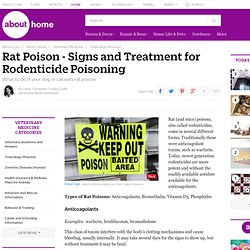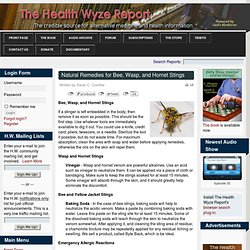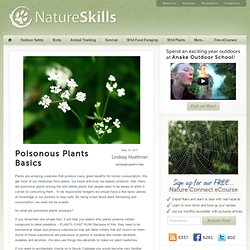

Where to Start with Pesticide Incidents. Each state has a designated state pesticide regulatory agency that regulates most pesticide-related matters.

They have the primary responsibility to investigate pesticide incidents, including potential pesticide misuse, drift, and off-target impacts. They can also help people evaluate pesticide work practices. On tribal land, the regulator may be a tribal designee, or the US Environmental Protection Agency (EPA). You can report pesticide incidents online, or call your Regional EPA Office to identify the right people to investigate. Ask to speak with someone in the pesticide program. National Pesticide Information Center - Home Page. Toxic Plants (by scientific name) - Safe and Poisonous Garden Plants. Rat Poison Primer - Types and Toxicities. Rat (and mice) poisons, also called rodenticides, come in several different forms.

Ethnobotany. Medica. Plant Guides. Daily Doses. BioHavoc Bivouac. HOMEOPATHY. Urinalyses. My Cology. On the Pharm. Spiders Slideshow: Black Widow vs Brown Recluse - RxList. Erowid MPTP Vaults: A Summary Article on MPTP its Symptoms and Toxicity, by H-Man. Newsgroups: alt.drugs From: an13187@anon.penet.fi (H-Man) Subject: MPTP article Message-ID: <1993Jul4.032852.25925@fuug.fi> Date: Sat, 3 Jul 1993 17:53:48 GMTMPTP-CONTAMINATED DESIGNER DRUGS - TREATMENT Please review the presentation and treatment of patients who have used MPTP-contaminated designer drugs.

DESIGNER DRUGS are analogs of known pharmacological agents, synthesized by underground chemists, for sale on the street. The concept of designer drugs is to manipulate the chemical structure of a narcotic, for example, and create a totally new compound. The "underground" chemist has two goals. First, is the belief that the nature and duration of the "high" experienced can be changed through chemical manipulations. Natural Cures For Allergic Reactions. Titanium allergy affects almost 4% of the population.

Titanium allergy symptoms can occur due to the metal itself or due to the chemical titanium dioxide, widely used in medications, confectioneries and cosmetics. The metal titanium is used in ear piercing, jewelry, and body implants such as dental implants. Symptoms Of Titanium Allergy. The Poison Help Line. Poison control center - emergency number: MedlinePlus Medical Encyclopedia.
For a POISON EMERGENCY call: This national hotline number will let you talk to experts in poisoning.

This is a free and confidential service. All local poison control centers in the United States use this national number. You should call if you have any questions about poisoning or poison prevention. You can call 24 hours a day, 7 days a week. United States Poison Centers. Essential First Aid Item: Activated Carbon. Activated carbon, in powdered form, should be in every medicine cabinet and first aid kit.

It is also known as activated charcoal. It is used around the world as a universal antidote for hundreds of poisons, including arsenic, mercury, pesticides, strychnine, warfarin, hemlock, E. Coli endotoxin, and gasoline. Over 4,000 chemicals, drugs, plant and microbial toxins, allergens, venoms, and wastes are effectively neutralized by activated charcoal, when it is given in sufficient quantities. Activated charcoal is also an effective detox for practically any drug overdose if administered in time.
In 1813, French chemist Michel Bertrand swallowed five grams of arsenic trioxide: 150 times the lethal dose. In 1831, in front of his distinguished colleagues at the French Academy of Medicine, Professor Touery drank a deadly cocktail of strychnine and lived to tell the tale. Manufacture and Storage Risks: Charcoal significantly decreases a body's absorption of all nutrients and medications. Activated Charcoal Contraindications. Natural Remedies for Bee, Wasp, and Hornet Stings. Bee, Wasp, and Hornet Stings If a stinger is left embedded in the body, then remove it as soon as possible.

This should be the first step. Use whatever tools are immediately available to dig it out. Naturally Treating Brown Recluse Spider Bites. Brown recluse spiders migrate into homes in the autumn, where warmer climates may be found.

These spiders reside in places with regular human movement, but they are not usually aggressive. They are known to bite when they feel threatened or trapped. Bites often occur when a spider is trapped between a piece of clothing and the human body. It is believed that they enjoy human dwellings because their nocturnal lifestyle benefits from artificial light. Brown recluse venom contains at least 9 distinct poisons; making it similar to rattlesnake venom. Avoiding Brown Recluse Bites. Snake Bites Quick Tip: Emergency Alternative Medicine For Snake Bites. Snake bites can be very dangerous, and we recommend immediately seeking emergency medical care, if it is available.

Hospitals are the only source for getting antivenin. However, there are scenarios when emergency medical assistance is hours or even days away. This article catalogs some treatments that can help in these situations. Apply dampened activated charcoal to snake bite fang wounds as soon as possible. With some snake bites, making a small slit in the fang lesions is necessary, while other bites leave large enough holes for the activated charcoal to absorb well.
Poisonous Plants Basics. Plants are amazing creatures that produce many great benefits for human consumption.

We get most of our medicines from plants, our foods and even our beauty products. Still, there are poisonous plants among the wild edible plants that people need to be aware of when it comes to consuming them. To be responsible foragers we should have a few basic pieces of knowledge in our pockets to stay safe. Poisonous Plants 1. Successful use of plants in a survival situation depends on positive identification.
Knowing poisonous plants is as important to a survivor as knowing edible plants. Knowing the poisonous plants will help you avoid sustaining injuries from them. Plants generally poison by-- Poisonous Plants 2. Plants basically poison on contact, ingestion, or by absorption or inhalation. They cause painful skin irritations upon contact, they cause internal poisoning when eaten, and they poison through skin absorption or inhalation in respiratory system. Many edible plants have deadly relatives and look-alikes. Preparation for military missions includes learning to identify those harmful plants in the target area.
Positive identification of edible plants will eliminate the danger of accidental poisoning. Pokeweed poisoning: MedlinePlus Medical Encyclopedia. Pokeweed is a flowering plant. Pokeweed poisoning occurs when someone eats pieces of this plant. This is for information only and not for use in the treatment or management of an actual poison exposure. If you have an exposure, you should call your local emergency number (such as 911) or the National Poison Control Center at 1-800-222-1222. Poisonous Ingredient PhytolaccatoxinPhytolaccigenin. Brugmansia, hyoscine, hyscyamine, tropane alkaloids. Brugmansia is a genus of seven species of flowering plants in the family Solanaceae. Their large, fragrant flowers give them their common name of angel's trumpets, a name sometimes used for the closely related genus Datura.
Brugmansia are woody trees or shrubs, with pendulous, not erect, flowers, that have no spines on their fruit. Datura species are herbaceous bushes with erect (not pendulous) flowers, and most have spines on their fruit.[2] Description[edit] Poisoning - Fish and Shellfish - Symptoms, Emergency, What to Do. Bivalve depuration: fundamental and practical aspects. Lee, R.; Lovatelli, A.; Ababouch, L. Vaccine Ingredients and Vaccine Secrets. There has been much recent concern regarding giving vaccines to children and the related side effects. Particularly concerning is the link between early childhood vaccines and autism. What follows will be a list of known ingredients inside vaccines, and their documented side effects. It will aid you in making informed decisions, which is something that the industry seems to be against. How many of these vaccine facts do you know? Pillbox - prototype pill identification system. RxNorm. Online Etymology Dictionary.
Cytomegalovirus. Species[edit] Several species of Cytomegalovirus have been identified and classified for different mammals.[3] The most studied is Human cytomegalovirus (HCMV), which is also known as Human herpesvirus 5 (HHV-5). Other primate CMV species include Chimpanzee cytomegalovirus (CCMV) that infects chimpanzees and orangutans, and Simian cytomegalovirus (SCCMV) and Rhesus cytomegalovirus (RhCMV) that infect macaques; CCMV is known as both Panine herpesvirus 2 (PaHV-2) and Pongine herpesvirus-4 (PoHV-4). Health References. Quotidiana. Healing Herbal. THE POISON GARDEN website - Book Review. 'Poisonous Plants: a guide for parents and childcare providers' A woman once told be how, when she was three years old, her father decided to remove a laburnum tree from the garden to avoid her being poisoned by it.
He had just felled the tree when he got called away to the front door. He returned to find his daughter opening another seedpod to get at the ‘peas’ inside it. The woman couldn’t remember any symptoms of poisoning but she did remember the unpleasant experience of having her stomach pumped. Common Non-Edible Plants. Top 10 Most Dangerous Plants in the World. 1. Most likely to eat a rat Giant Pitcher Plant: Nepenthes attenboroughii Discovered more than 5000 feet above sea level on Mount Victoria in the Philippines, the giant, carnivorous pitcher plant secretes a nectar-like substance to lure unsuspecting prey into a pool of enzymes and acid. A series of sticky, downward ribs makes it nearly impossible for trapped prey to escape.